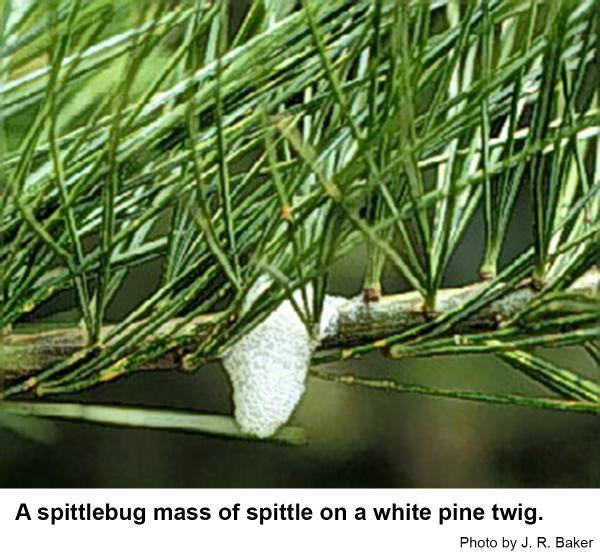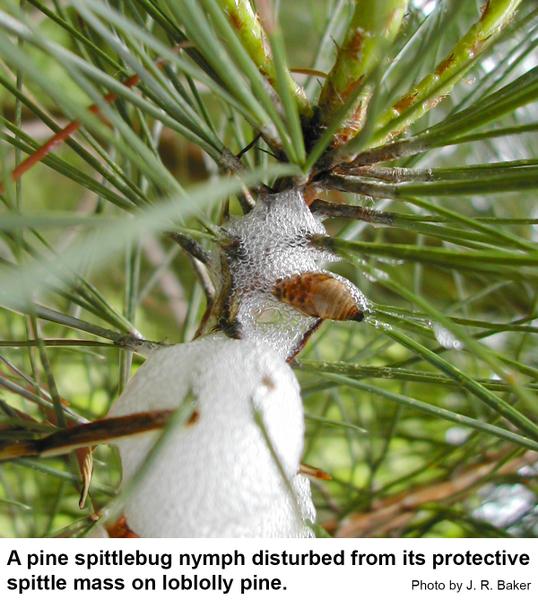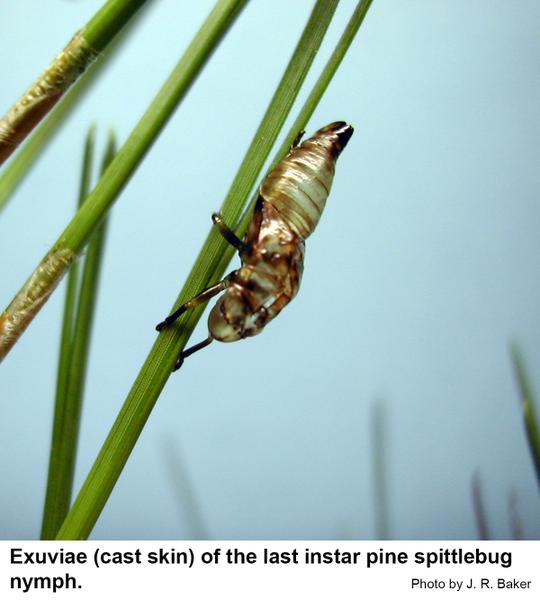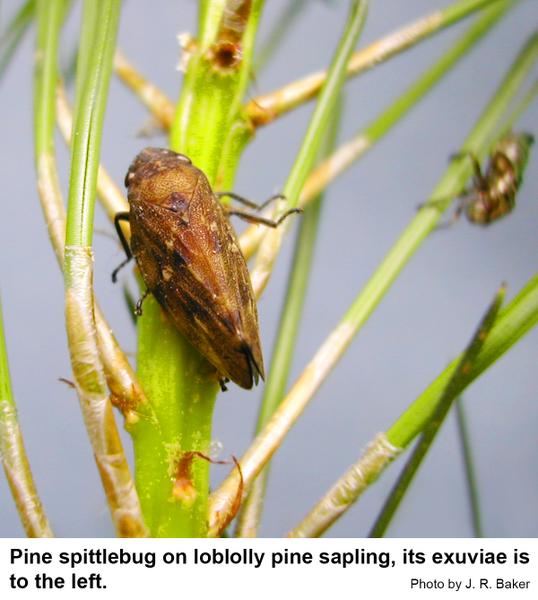Description and Biology
Adult pine spittlebugs, Aphrophora parallela, are tan to dark reddish brown and about 3/8 inch long. They resemble large, chunky leafhoppers. In July and August, female pine spittlebugs lay their eggs in dead wood or under the bark of live stems of pines, spruces, firs, hemlock and other conifers. The teardrop-shaped eggs can be found under bud scales, in needle sheaths, or under the bark of dead twigs. The the egg stage lasts until the following spring when the nymphs hatch and begin to feed right through the bark. Young pine spittlebug nymphs are red and black, whereas mature nymphs are chestnut brown. Spittlebugs suck sap out of the plants with their needle-like mouthparts. As the nymphs feed, they excrete "spittle" that protects them from predacious mites and insects. Pine spittlebugs tend to be more abundant during dry seasons perhaps because dry weather inhibits the parasitic fungus, Entomophthora aphrophorae. On the other hand, high temperatures cause some mortality of the nymphs. There is only one generation per year.
Host Plants
The pine spittlebug prefers eastern white, Scotch, and jack pine, although other pines as well as Leyland cypress, junipers, spruces, hemlock, and fir are suitable hosts. In heavy infestations, trees die from the top down in 2 or 3 years. Symptoms include flagging branches, dead terminal growth, and stunted and distorted stems and branches apparently caused by Diplodia pini, a fungus that invades the tree through the feeding punctures. Adult feeding causes characteristic red flecks and pitchy scars in the wood just below the bark. Although several spittlebugs are associated with pine, only the Saratoga and pine spittlebugs are serious pests in the eastern United States.
Residential Recommendations
Supposedly the pine spittlebug can be managed by pruning out the dead and dying branches in which females are likely to deposit eggs. Heavily infested Leyland cypress, junipers or pines can be treated with most insecticides labeled for landscape use (including insecticidal soaps and horticultural oils) when the spittle masses and spittlebugs are present in the spring and early summer .
References
- Pine Spittlebug – Its Ecology and Management. Wilson, L. F. 1991. USDA Forest Service Agr. Handbook 695. 18 pp.
- Insect and Related Pests of Shrubs. Baker, J. R. ed. 1980. NC Agricultural Extension Service publication AG-189. 199 pp.
- Extension Plant Pathology Publications and Factsheets
- Horticultural Science Publications
- North Carolina Agricultural Chemicals Manual
For assistance with a specific problem, contact your local N.C. Cooperative Extension Center.
This Factsheet has not been peer reviewed.
Publication date: May 10, 2016
Reviewed/Revised: Oct. 10, 2019
Recommendations for the use of agricultural chemicals are included in this publication as a convenience to the reader. The use of brand names and any mention or listing of commercial products or services in this publication does not imply endorsement by NC State University or N.C. A&T State University nor discrimination against similar products or services not mentioned. Individuals who use agricultural chemicals are responsible for ensuring that the intended use complies with current regulations and conforms to the product label. Be sure to obtain current information about usage regulations and examine a current product label before applying any chemical. For assistance, contact your local N.C. Cooperative Extension county center.
N.C. Cooperative Extension prohibits discrimination and harassment regardless of age, color, disability, family and marital status, gender identity, national origin, political beliefs, race, religion, sex (including pregnancy), sexual orientation and veteran status.




